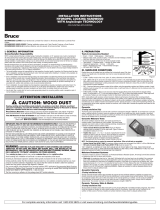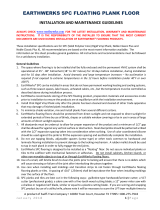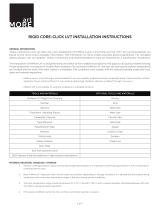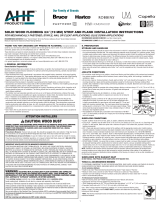Page is loading ...

Rigid Core SPC Locking Installation System
THANK YOU FOR CHOOSING AHF PRODUCTS FLOORING.
If properly installed and cared for, your new looring will be easy to maintain and will
look great for years to come. If you have questions or comments, please visit us at www.
ahfproducts.com or 1-866-243-2726.
These directions are based on industry standards and best practices. Failure to follow
these installation instructions may result in damage to the looring and void the loor’s
warranty.
• For complete warranty information call 1-866-243-2726 or go to www.ahfproducts.com.
• For technical or installation questions, or to request a Safety Data Sheet, please call
1-866-243-2726 or visit www.hardwoodexpert.com our technical website.
• For general questions or comments, please visit us at www.ahfproducts.com or call
1-866-243-2726.
WARNING: EXISTING IN-PLACE RESILIENT FLOOR COVERING AND ASPHALTIC
ADHESIVES. DO NOT SAND, DRY SWEEP, DRY SCRAPE, DRILL, SAW, BEADBLAST,
OR MECHANICALLY CHIP OR PULVERIZE EXISTING RESILIENT FLOORING,
BACKING, LINING FELT, ASPHALTIC “CUTBACK” ADHESIVE, OR OTHER
ADHESIVE.
These existing in-place products may contain asbestos ibers and/or crystalline
silica. Avoid creating dust. Inhalation of such dust is a cancer and respiratory tract hazard.
Smoking by individuals exposed to asbestos ibers greatly increases the risk of serious
bodily harm. Unless positively certain that the existing in-place product is a non-asbestos-
containing material, you must presume it contains asbestos. Regulations may require
that the material be tested to determine asbestos content and may govern removal and
disposal of material.
Visit rfci.com to see the current edition of the Resilient Floor Covering Institute (RFCI)
publication Recommended Work Practices for Removal of Resilient Floor Coverings for
instructions on removing all resilient loor covering structures or contact your retailer.
AHF loor coverings and adhesives do NOT contain asbestos.
Installation: All Grade Levels
Tools: Tapping Block, Pull Bar, Rubber Mallet, Utility Knife, Saw (optional), Multi loor cutter,
Spacers, Armstrong Flooring™ S-295 Flooring Adhesive (optional), 6 mil poly ilm moisture
barrier for concrete subloors (loating installations only)
GENERAL INFORMATION
The locking installation system allows the planks to be installed without using adhesive.
It is a loating loor installation. The planks should be installed 1/4˝ away from all vertical
objects such as walls, cabinets, pipes, etc.
Adhesives: If a full spread glue down installation is desired with the Rigid Core SPC
looring, use Armstrong Flooring™ S-295 Flooring Adhesive with the recommended trowel
found on the pail. Follow the manufacturer’s instructions for the adhesive application.
When installed in bathrooms, the expansion gap should be illed and sealed with a good
quality 100% silicone caulk. The gap can then be covered with molding or wall base. Base
cabinets should not be installed on top of the planks.
KEYS TO SUCCESSFUL LOCKING INSTALLATION
• Most installations will need approximately a 10% cutting allowance added to the square
footage of the room.
• Proper conditioning of the job site is necessary. Flooring planks should not be exposed to
sudden changes in temperature.
• Store, transport and handle the looring planks in a manner to prevent any distortions.
Distortions will not disappear over time. Store cartons lat, never on edge. Ensure that the
looring planks are lying lat during installation.
• Installations of carpet, metal strips and other transition moldings should not pinch the
looring against the subloor, and should allow for some slight movement wherever
practical.
• Protect the loor from heavy-rolling loads, other trades, and movement of appliances by
using sheets of plywood or similar.
SUITABLE SUBSTRATES
All substrates listed below must be properly prepared and meet certain requirements. There
may be other exceptions and special conditions (as noted below) for these substrates to be
suitable for the locking installation system.
• Concrete – dry and smooth on all grade levels
- A 6 mil poly ilm moisture barrier is must be used over concrete subloors. Failure to use
a moisture barrier could affect the integrity of the SPC installation, or your warranty.
• Suspended wood subloors with approved wood underlayments – must have minimum of
18˝ well-ventilated crawl space underneath
• Suspended hardwood looring that is fully adhered, smooth and square edge without
texture
– SPC should be installed perpendicular to the direction of the existing wood loor
• Single-layer, fully-adhered, existing resilient loors – must not be foam-backed or cushion-
backed
• Ceramic tile, Terrazzo, Marble
• Polymeric Poured (seamless) Floors
• OSB-3/4”
• Particleboard 40lb. density or waferboard
DO NOT INSTALL OVER
• Existing resilient tile loors that are below grade
• Existing cushion-backed vinyl looring
• Carpet
• Hardwood looring installed directly over concrete
• In rooms with sloping loors or loor drains
• Existing loating loors
JOB CONDITIONSPREPARATION
• Resilient looring should only be installed in temperature-controlled environments. It is
necessary to maintain a constant temperature before, during and after the installation.
Therefore, the permanent or temporary HVAC system must be in operation before the
installation of resilient looring. Portable heaters are not recommended as they may not
heat the room and subloor suficiently. Kerosene heaters should never be used.
• All substrates must be structurally sound, dry, clean, lat, and smooth with minimal
delection. Substrates must be free from excessive moisture or alkali. Remove dirt, paint,
varnish, wax, oils, solvents and other foreign matter, and contaminates.
- Subloors must be lat within 3/16” in 10’ or 1/8” in 6’
- For concrete substrates moisture testing should be conducted and moisture vapor
emissions should not exceed 5lbs. per 1,000 ft2 (calcium chloride) and/or relative
humidity exceeding 95% (in-situ probe)
• High spots on the substrate should be leveled and low areas illed with appropriate
underlayments.
• Do not use products containing petroleum, solvents or citrus oils to prepare substrates as
they can cause staining and expansion of the new looring.
• For renovation or remodel work, remove any existing adhesive residue so that 100% of the
overall area of the original substrate is exposed.
• Ceramic tile loors, ceramic and marble grout joints, and irregularities in concrete should
be illed and leveled using a cementitious patch to ill and smooth any embossing in the old
loor.
• The area to receive resilient looring materials and adhesives should be maintained between
65°F (18°C) and 85°F (29°C) for 48 hours before installation, during installation, and 48
hours after completion. Maintain temperatures between 32°F (0°C) and 140°F (60°C)
thereafter.
• Radiant heated substrates must not exceed a maximum surface temperature of 85°F
(29°C).
• The subloor panels must have a smooth, sanded face and show no swelling of edges or
surface due to exposure to weather conditions or construction trafic.“
• There are numerous products available for use as loor ills, patches, self-leveling
underlayments, and trowelable underlayments. They include proprietary blends of
compounds such as portland cement, calcium aluminates, and gypsum-based products.
These are recommended by their manufacturers for smoothing rough or uneven subloors,

Rigid Core SPC Locking Installation System
enhancing acoustical and ire characteristics of structures or as substrates to receive
loor covering for otherwise unsuitable subloor conditions. If the subloor surface
appears to be dusty then apply a primer to the surface.
SAFETY AND CLEAN UP:
Wet adhesive should be cleaned up immediately with soap and water on a clean cloth.
Dried adhesive may require the use of a solvent-based adhesive cleaner.
• Plan the layout so seams in the new looring fall at least 6˝ (15.2 cm) away from seams
and joints in existing looring and underlayments.
• Remove wall base and quarter-round moldings.
• The decorative trim and jamb moldings at doorways should be under-cut to allow looring
to slip underneath as you can’t hide perimeter gap with wall base in these areas.
• After preparation work is completed, be sure to sweep and vacuum entire work area
taking extra care to remove all dirt and debris.
INSTALLATION PREPARATION
Remove baseboard, quarter-round moldings, wall base, appliances and furniture from
room. For best results, door trim should be under-cut to allow looring to move freely
without being pinched. After preparation work, sweep and vacuum the entire work area to
remove all dust and debris.
Whenever possible, plan the layout so that the joints in the planks do not fall on top of
joints or seams in the existing substrate. The end joints of the planks should be staggered
a minimum of 6˝ apart. Do not install over expansion joints. Avoid installing pieces shorter
than 8˝ (20.32 cm).
Determine which direction the plank will run. Find the center of each of the end walls (the
walls perpendicular to the long dimension of the planks and place a pencil mark on the
loor. Connect these points by striking a chalk line down the center of the room. Do a dry
layout of planks from the center line to the wall running parallel to the long direction of the
planks to determine the width of the last row of planks (refer to Figure 1).
CENTER
OF ROOM
Fig. 1 – Dry layout to determine width of border plank.
Avoid having border pieces less than half with width of the planks. If you ind the border
planks will be less than 1/2 the width of the plank, the center starting line should be shifted
a distance equal to 1/2 the plank width. This will “balance” the room and provide for a larger
cut piece at the wall.
NOTE: The subloor must be thoroughly free from dust and debris. If the subloor is dusty
this may affect the product performance.
NOTE: Stagger end joints by 6”. Cut pieces at the ends of rows should be 8” long or longer.
Position the irst plank so that groove edge is facing you. Install the product from left to
right in the room. See Figure 2 for position of initial plank in the room.
Starting Wall
Fig. 2 – Left corner of starting wall.
Occasionally, it may be necessary to install backwards. This may be done by sliding the
grooves under the tongues and working them right to left, but this is more dificult.
Install First Row
1.Inspect each piece prior to installation for damaged planks.
2.To minimize pattern repeats, always pull from at least 3 cartons while installing.
3.Lay irst row of boards with tongue side facing the wall.
4. If the starting wall is crooked, trace the contour of the wall on the irst row of planks and
trim as needed.
5. Use spacers along all sides that butt up against walls to maintain 1/4” (6.35 mm) expansion
zone.
6. Lay pieces from left to right. Lock the end joints by aligning the end tongue with the end
groove of the previous board then tapping the joints together with a soft rubber mallet.
7. When measuring the last piece in the row, subtract 1/4” (6.35 mm) from the end of the
board to maintain expansion zone.
8. Cut decorative side up if using a hand saw or decorative side down if using a power saw to
minimize chipping. A utility knife may also be used.
9. If the cut-off piece from the irst row is 8” (20.32 mm) or longer, use it to start the second
row. If it is less than 8” (20.32 mm), cut a full board in half and use that.
Install Remaining Rows
1. Continue laying planks, one row at a time and staggering the end joints.
2. Install the long edge of the irst board in the second row at an angle to the board in the
irst row. Press lat to subloor to lock into place. A scrap piece of material can be used as a
tapping block to ensure the long edge is properly engaged.
3. Angle the long edge of the next board in the second row to lock into the irst row (ig. 5)
while positioning the short end of the board over the groove from the previous board. Lock
and fold, then tap into place using a rubber mallet. (ig. 6)
4. Follow the order described above to continue laying the boards in the second and
additional rows.
5. Use of a rubber mallet may be necessary to tighten joints.
Continue installing planks. Maintain a random appearance by offsetting the end joints by
at least 6”. Always be certain that the planks are fully engaged. If slight gapping is noticed,
place a cut piece of looring (bridge piece) in the side groove that spans the ends of two
adjacent planks within a row. Then tap the side of the plank with a tapping block.
When itting in areas such as door casings it may be necessary to use a lat pull bar to
engage the lock.
Continue installing the remaining rows in similar fashion. For planks, maintain the 6˝
minimum staggered end joints between rows and maintain the 1/4” gap at perimeter and
vertical objects.
Fig. 3 Fig. 4
Fig. 5 Fig. 6

Rigid Core SPC Locking Installation System
AF-1060-923 | Armstrong Flooring and the Armstrong Flooring logo are trademarks of AWI Licensing LLC. All other trademarks are owned by AHF, LLC. | © 2023 AHF, LLC.
If planks need to be disengaged it is crucial to slide them apart (ig. 7) in order to maintain
the integrity of the lock. If this is not done properly the lock can break.
OPTIONAL: GLUE DOWN PROCEDURE
If a full spread glue, down installation is desired, use Armstrong Flooring™ S-295 Flooring
Adhesive. Follow the manufacturer’s instructions for adhesive application.
Apply a suficient amount of Armstrong Flooring™ S-295 Flooring Adhesive using the
recommended trowel at the starting wall in an area that can be covered within the working
time of the adhesive. Be sure not to spread adhesive too far ahead of your work area.
Begin laying planks in the adhesive after the recommended open time of the adhesive and
install row by row using the same locking installation described above including the cut
pieces at the perimeter until half of the installation is complete. Stagger the end joints by
at least 6” (15.2 cm). Continue applying adhesive in the same fashion being careful not to
spread too far beyond the working area. Allow the adhesive to dry-to-touch and complete
the installation of planks in similar fashion.
After the planks are installed, immediately roll the entire loor with a 100 lb. roller. Use a
hand roller in conined areas where the large loor roller will not reach, such as under toe
kicks.
The planks may be walked on immediately; however, the loor should not be exposed to
heavy rolling load trafic for 72 hours after the installation. Use pieces of hardboard or
underlayment panels to protect the loor when moving heavy furniture and appliances
back into the room.
FINISHING THE INSTALLATION
Replace molding or wall base, allowing slight clearance between the molding and the
planks. Nail the molding to the wall surface, not through the looring. At doorways and at
other areas where the looring planks may meet other looring surfaces, it is preferable to
use a “T - molding , or similar, to cover the exposed edge but not pinch the planks. Leave a
small gap between the planks and the adjoining surface.
PROACTIVE PROTECTION FOR YOUR FLOOR
• When moving appliances or heavy furniture it is always wise to lay a plywood panel, or
similar, on your loor and “walk” the item across it. This protects your loor from scufing,
gouging and tears.
• Use loor protectors under furniture to reduce indentation. As a general rule of thumb,
the heavier the item, the wider the loor protector needed.
• Place a walk-off mat at outside entrances to reduce the amount of dirt brought into
your home. We strongly recommend mats without a latex or rubber backing since these
backings can cause permanent discoloration.
CARING FOR YOUR FLOOR
• Sweep or vacuum regularly, to remove loose dirt which can scratch your loor.
NOTE: We do not recommend vacuums that have a beater bar since it can visibly
damage your looring surface. Additionally, we do not recommend electric brooms with
hard plastic bottoms with no padding as use may result in discoloration and deglossing.
• Wipe up spills as soon as possible. Never use highly abrasive scrubbing tools on any
resilient loor.
• Wash your loor regularly with a vinyl loor cleaner such as Armstrong Flooring™ Once ‘n
Done Floor Cleaner.
• Do NOT use detergents, abrasive cleaners, or “mop and shine” products. These products
may leave a dull ilm on your loor.
• Over time, if the shine on your loor begins to dull, apply a low gloss loor inish for
resilient loors to restore the appearance of rigid core looring. Do NOT use paste wax or
solvent based polishes.
• Vinyl looring, like other types of smooth loors, can become slippery when wet. Allow
time for loor to dry after washing. Immediately wipe up wet areas from spills, foreign
substance, or wet feet.
REPAIR PROCEDURE
For detailed repairs, please log on to AHF Products www.hardwoodexpert.com
Fig. 7
/



